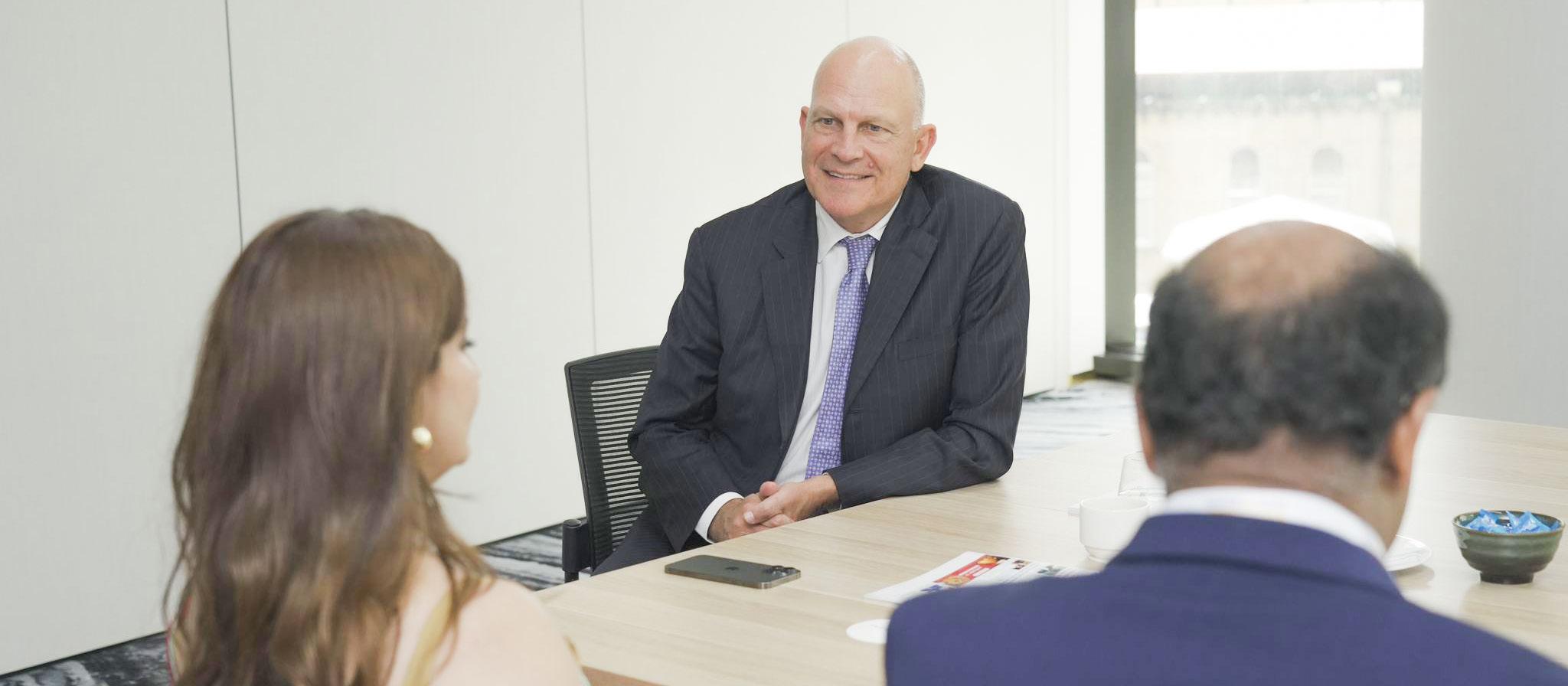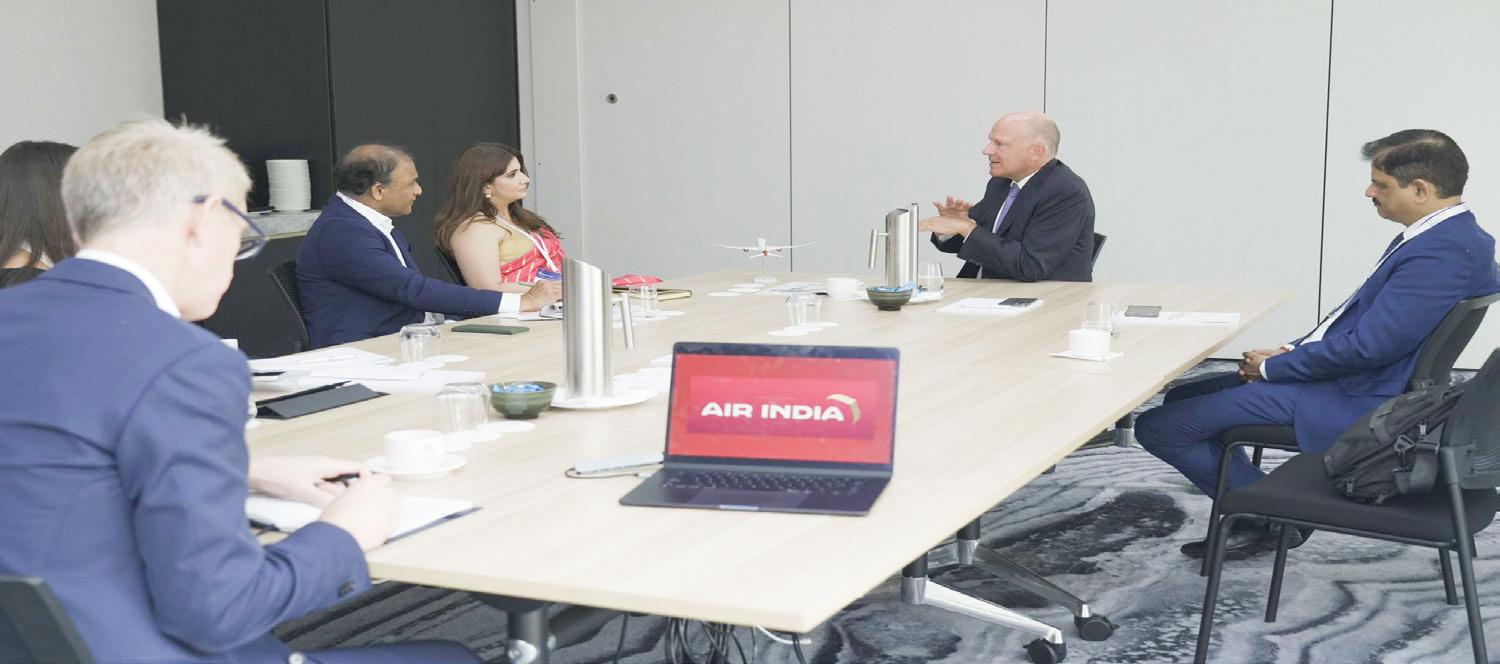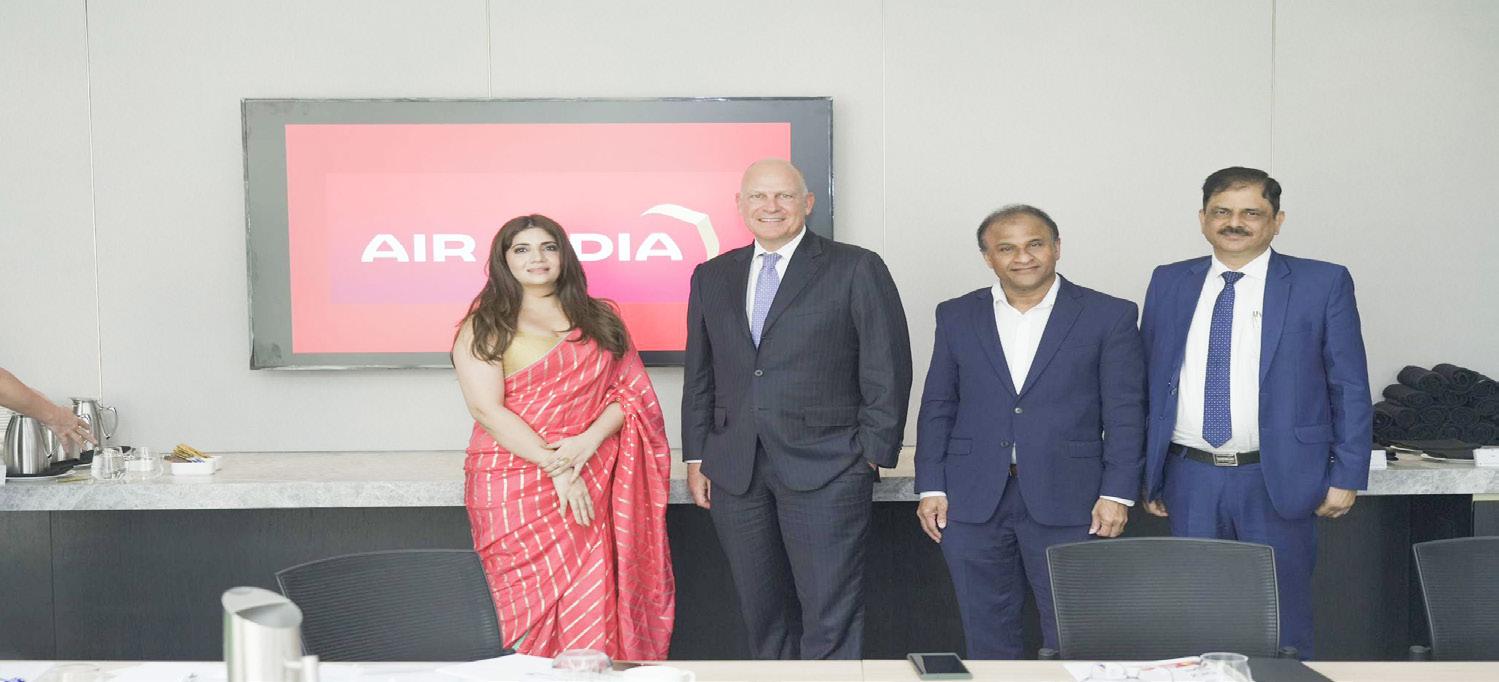
9 minute read
Air India’s $70 Billion Makeover Restructuring and revitalising for Air India: Interview with CEO Campbell Wilson
Since its inaugural flight in 1932, India’s oldest airline has had quite the journey. J.R.D. Tata, who made history as the first Indian to earn a commercial pilot license, founded what was originally known as Tata Airlines. By 1946, it had been renamed Air India and became a public company. Nationalization in 1953 led to a domestic air travel monopoly that lasted until the early '90s. The airline faced mounting financial issues over the years, and in 2021, it was privatized with Tata Group's US$2.3 billion acquisition. After more than 70 years under government control, Campbell Wilson, a 53-year-old New Zealander with a background in Singapore Airlines and its low-cost carrier Scoot, took on the challenge of transforming Air India into a modern competitor. Under his leadership, the airline has seen its revenue more than double, with Air India Connect also experiencing significant growth.


In an exclusive interview with Australia India News Chairman Dr Ram Mohan, and Associate Editor Kriti Bhardwaj, CEO of Air India Campbell Wilson spoke about Air India’s transformation with a $70 billion investment in modernizing its fleet and technology, aiming for enhanced service and sustainability. He also emphasized the challenge of completing the Vistara merger by November 12th while expanding the airline’s network and addressing community demands for direct flights.

Question: Air India has been undergoing a significant transformation since the Tata Group acquisition. Can you share specific milestones achieved under your leadership, and what challenges remain in revitalizing the airline?
Wilson Campbell: Prior to privatization, Air India was on an unsustainable path, lacking a private sector performance mentality and focus on consumer excellence. The airline had not recruited new IT or non-flying staff for nearly 15 years, resulting in an average employee age of 54 and a culture resistant to innovation.
Under my leadership, we’ve made significant strides. We’ve recruited thousands of new staff, reducing the average age to 34, and built a 600,000-square-foot training academy, alongside launching a new cadet pilot program with advanced technology. These changes have fostered a mindset shift and enhanced our capacity for training.
Our team, despite the rapid and challenging turnaround, has shown exceptional passion and capability. The challenge now is to maintain this momentum and continue evolving Air India into a modern, competitive airline.
Question: Given the highly competitive nature of the aviation market, how is Air India working with international carriers to expand its network, particularly in regions like Australia and Southeast Asia?
Wilson Campbell: In the highly competitive aviation market, Air India is focusing on strategic mergers and partnerships to enhance our network. We are merging Air India with Vistara to form a consolidated full-service carrier and combining AIX Connect with Air India Express to create a larger low-cost airline. These moves are designed to strengthen our market position and expand our reach.
By consolidating our operations, we aim to offer more robust services and improved connectivity, particularly in competitive regions like Australia and Southeast Asia. This strategic approach will enable us to better compete on a global scale and capitalize on emerging opportunities in these key markets.
Question: Amidst all the significant changes happening at Air India, what is the one thing keeping you up at night?
Wilson Campbell: (Laughs) As the CEO of an international airline, there's a lot that can keep me up at night, given the complexity of our operations and changes. However, the one thing that stands out is the upcoming go-live date for our merger services on November 12th. This date is critical because it marks the culmination of numerous dependencies and preparations that must be perfectly executed. From regulatory approvals to logistical transitions and booking systems, everything needs to be seamless and ready for the transition. Ensuring that all aspects are in place for a smooth go-live is a major focus and a significant challenge for my team
Question: Air India has placed one of the largest aircraft orders in recent aviation history. How will this new fleet shape the airline’s future growth, and what changes can passengers expect in terms of service and sustainability?
Wilson Campbell: The Tata Group has committed tens of billions to transform Air India, with a significant focus on investing in a new fleet of 470 aircraft, modernizing cabins, refreshing the brand, and enhancing customer service. This capital-intensive plan aims to address the airline's ageing fleet, which had been neglected for decades.
The recent addition of 36 leased aircraft, including 11 Boeing 777s and 25 Airbus A320s, allowed us to launch six new international routes and increase frequencies on 24 others. However, the cornerstone of our transformation is our ambitious order of 470 new Airbus and Boeing aircraft, costing $70 billion. This includes 140 A320neos, 70 A321neos, and 190 737 MAX aircraft. These new additions will enable us to operate one of the most advanced and fuel-efficient fleets in the industry within five years.
In parallel, we are investing $400 million to retrofit our existing fleet. The retrofit will initially focus on our narrow-body A320neo and A321neo aircraft, followed by a comprehensive overhaul of 40 legacy wide-body Boeing 777s and 787s with all-new interiors.
Passengers can expect several improvements as a result of these investments. We will introduce premium economy seats on selected long-haul flights and new food menus to enhance the onboard experience. These changes not only improve service but also contribute to our sustainability goals by incorporating the latest, fuelefficient technologies and modernizing our fleet. This comprehensive approach is designed to position Air India for substantial growth and better service in the dynamic Indian aviation market.
Question: The Indian aviation market is highly competitive and price-sensitive. How does Air India plan to differentiate itself from other domestic carriers, and what strategies are in place to maintain profitability while ensuring customer satisfaction?
Wilson Campbell: Air India plans to differentiate itself by expanding its network and leveraging its new widebody aircraft. As we grow, we are focusing on enhancing our longhaul routes, such as increasing flights between Delhi and London Heathrow, and adding new destinations in the US, like San Francisco and New York.
To compete with major domestic and international carriers, such as IndiGo and Middle Eastern airlines like Emirates and Qatar Airways, we are enhancing our service offerings and improving direct connectivity. Our new widebody aircraft, including the Airbus A350s, will enable us to provide more direct flights and better compete on long-haul routes.
Additionally, the upcoming merger with Vistara will boost our fleet with more widebody aircraft, further expanding our network and service capabilities. Our focus is on increasing capacity and frequency, particularly in key markets, which will help us maintain profitability while delivering a high level of customer satisfaction.
Question: Sustainability is becoming a key focus for airlines globally. What steps is Air India taking to reduce its carbon footprint and improve sustainability, and how do you see this influencing future operations?
Wilson Campbell: Air India is committed to reducing its carbon footprint as part of IATA’s “net zero by 2050” goal. We are investing in new aircraft, like the Airbus A350s, which are designed to operate on blended sustainable aviation fuel (SAF). Although SAF is currently four times the price of conventional fuel, scaling up its production and reducing costs are essential for making it a viable solution.
Our approach to sustainability involves a combination of using advanced aircraft, adopting SAF, and exploring carbon offset options. This comprehensive strategy will shape our future operations by driving technological advancements and operational efficiencies, ultimately supporting our longterm sustainability goals and reducing our environmental impact.
Question: In terms of the extensive changes happening at Air India, what will it take to change the perception of the brand, and how does Air India plan to attract and alter that perception?
Wilson Campbell: Changing Air India's perception involves a multi-faceted approach. We’ve initiated a major rebranding effort supported by a $70 billion investment in 470 new Airbus and Boeing aircraft. These planes feature upgraded cabins, including business-class privacy doors, premium economy seating, and enhanced coach seats. We are also expanding our team by hiring over 5,000 new employees, including cabin and cockpit crew, and implementing new compensation and rostering systems to improve morale and performance.
Our rebranding includes a new logo, livery, font, color palette, and uniform collection, alongside an upgraded digital presence with a new website, mobile app, and a 24/7 customer contact center in multiple languages. Additionally, we are rolling out a redesigned loyalty program. Early feedback on our new Airbus A350s has been positive, highlighting the improved cabin, service, and comfort, which supports our efforts to reshape the brand's image and attract more customers.
Question: What is Air India’s position on the community's demand for direct flights from Australia to India, and how does this fit into the airline’s broader plans?
Wilson Campbell: Air India recognizes the strong community demand for direct flights from Australia to India. Currently, our ability to launch such routes is limited by the availability of wide-bodied aircraft, which are essential for long-haul flights. As we receive more of these aircraft, we will be better positioned to expand our long-haul routes, including those to Australia. Our expansion plans also include increasing long-haul services to the U.S. This expansion is driven by both prioritization and demand. While we can’t provide an exact timeline for when direct flights to Australia might start, it remains a key part of our strategy as we continue to enhance our fleet and network capabilities.
Question: How does Air India plan to leverage advancements in technology and AI to enhance its operations, and what role do you see these technologies playing in the airline’s future?
Wilson Campbell: Air India is actively integrating advanced technologies to enhance our operations. Key initiatives include a revamped website and mobile app, which are highly rated by users, and the implementation of a generative AI chatbot, A.DOT G. This chatbot efficiently handles complex customer queries with a 93% containment rate, meaning only 7% of queries require human intervention.
These technological advancements are designed to improve customer service and streamline operations, demonstrating the significant impact AI can have on enhancing our overall passenger experience. As we continue to develop and deploy these technologies, they will play a crucial role in shaping Air India’s future by increasing efficiency and customer satisfaction.










